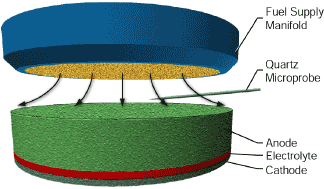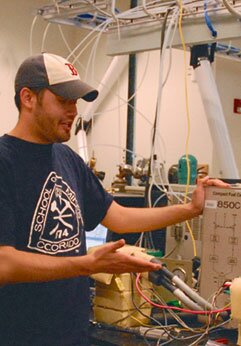The boundary-layer profiles can be used to infer critical information about the global catalytic chemistry at the catalytic stagnation surface. A new fully enclosed reactor has been developed, which enables the use of hazardous gases and sub-atmospheric operation. More information may be found in Applied Catalysis A, 255:279-288 (2003).
Catalytic stagnation-flow reactor
In typical catalytic reactors (e.g., monoliths, packed beds, porous-foam supports), it is difficult, if not impossible, to observe directly the catalyst surface. Therefore, we have developed a stagnation-flow reactor that enables direct experimental observation of the catalyst surface and the adjacent gas-phase boundary layer. Microprobe mass-spectrometric sampling is used to measure species profiles in the stagnation-flow boundary layer.

